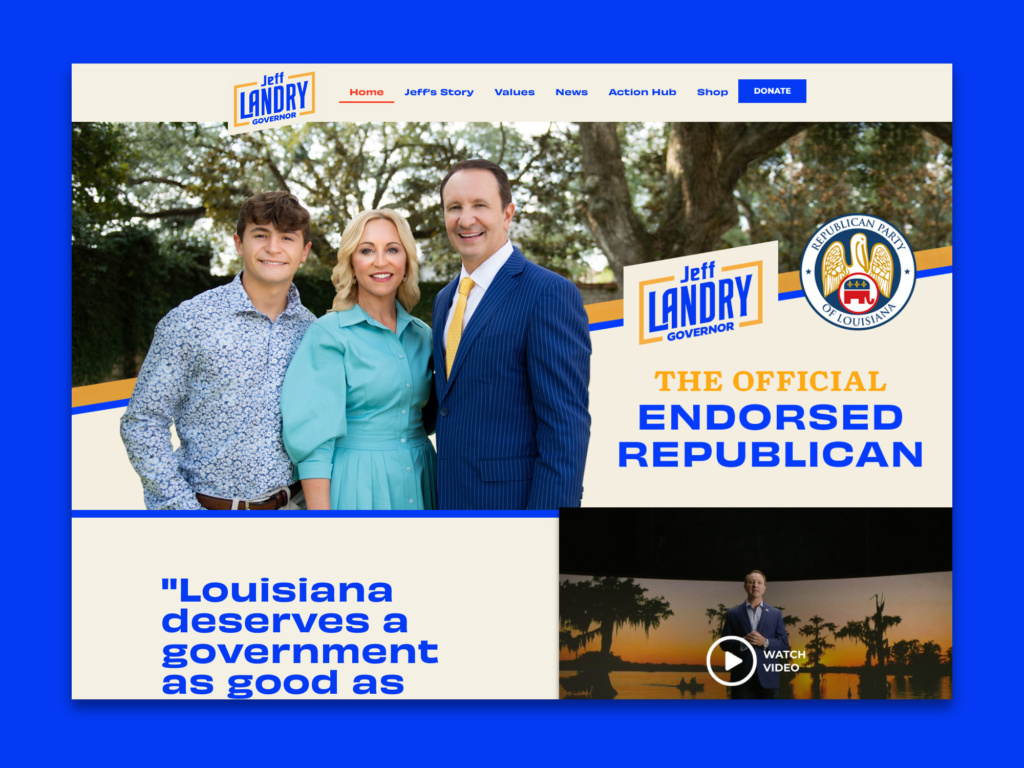Jeff Landry won a historic election to become Louisiana’s 57th Governor in an outright victory that stunned political watchers. Facing a crowded field of 6 significant candidates and three lingering prospective campaigns by a US Senator, US Congressman, and an incumbent Lt. Governor. After announcing early, Landry and his team ran a methodical campaign focused on broadening his base beyond an established Trump electorate and into a swing group of voters that cemented his frontrunner position and a historic primary election win.
All systems, geaux! Jeff Landry’s winning campaign was one of the most methodical, multi tiered, and disciplined in state history. Every aspect excelled, and week after week, it flawlessly advanced his message and, ultimately, his public support.
Branding and Website
As a known entity in Louisiana, the Attorney General Jeff Landry, entered the Governor’s race looking to show the state the energy and fresh start he represented. Inspired by Louisiana’s blue and gold flag, a fresh similar palette was chosen with a soft cream addition to add warmth and a touch of nostalgia. The logo adaptation also played upon the Landry’s first to letters of this name coincidently matching the states abbreviation. That creative coincidence allowed for spin-off branding opportunities that were parlayed into lapel pins, brand marks and additional merchandise.

The Landry campaign website was built on a state-of-the-art CMS system with nearly a dozen campaign workers populating content on the easy to navigate and surprisingly simple, yet thorough campaign tool. Under the hood, the website was tied real-time into a robust CRM tool that collected data on tens of thousands of donors, volunteers and activists. The website and the CRM tool became the hub of the campaigns volunteer messaging and recruitment. Additionally, specific thematic landing pages were launched to support particular tv campaigns, direct mail efforts and public relations stories.

Building Momentum with Video
Landry began the campaign with a meager 24% and a wide-open race with half of the electorate up for grabs. In his 8-minute announcement video, Landry linked his storied biographical background into a resonating story that demonstrated a thoughtful relevance to the issues of crime, economic development, and education. That video would set the tone and tenor for the next 12 months of messaging and persuasion.
Landry shattered fundraising records month after month and importantly, those campaign dollars were effectively used to fund ads that raised his positives, locked down leaning voters, and inoculated him from seven-figure negative attack campaigns.
With the advertising window open, the campaign controlled the debate. Early advertisements featured the future First Lady speaking to Landry’s character and history as someone who had walked in the very shoes of the people as a sugar cane farm worker, a police officer, and a veteran.
Landry’s campaign continually climbed in the polls – despite opponents collectively outspending him two to one, and dropping millions in negative against him. The campaign was a steady machine, growing in polling increments consistently until the final survey predicted Landry would receive 42%. This was not enough to win outright and avoid a contentious and expensive runoff in which the DGA and others would play big to hold onto the Governor’s mansion.
The Landry campaign had one silver bullet left – its digital targeting and message operation. Outgoing Governor Edwards (D) won his elections because of complacent Republican voters who were eager to turn out in a Presidential election but opted to stay home in Gubernatorial elections. The data/messaging teams hatched an operation that combined persuasion and GOTV to target the approximately 300,000 voters who voted in the 2016 & 2020 elections but not the 2019 Gubernatorial. Those 300k voters were targeted with data-modeled messages and pounded via direct mail, digital, phones, and social with personalized, persuasive topics (i.e., President Trump, Social Issues, Crime, Education, Healthcare, etc.).
In the end, 186,000 of the traditional Gubernatorial “dead weight” voters turned out to cast their ballots representing nearly 20% of Jeff Landry’s total statewide vote and nearly 10% of the votes cast. Without that sophisticated, creative messaging, Jeff Landry would not have won in the primary with 52% and instead finished in the low 40s.